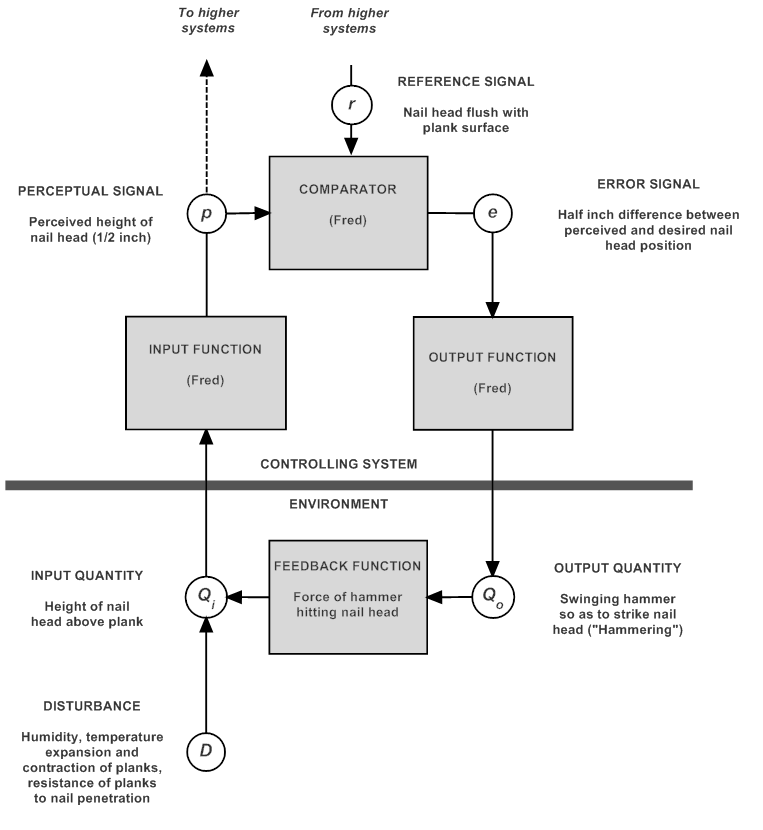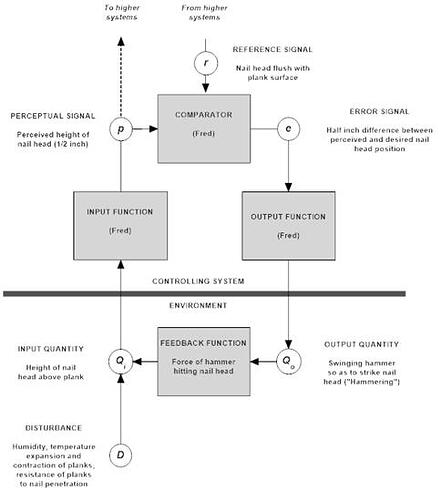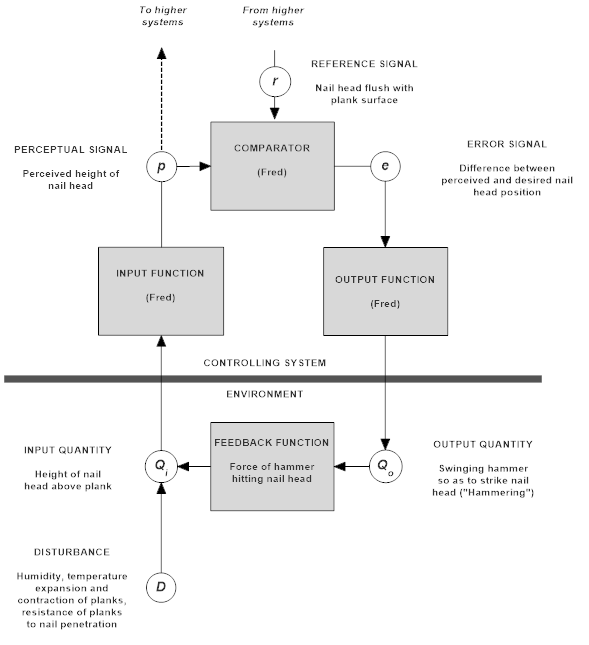[From Fred Nickols (2015.11.15.1815)]
I know, I’m responding to my own post.
Here’s the problem I’m having.
The Feedback Function, as I understand it, is how my output (Qo) is connected or linked to the controlled variable (Qi).
Ordinarily, I would consider “feedback� to be changes in the height of the nail head. I hit the nail with the hammer and it moves down (or doesn’t as the case may be).
However, I’m thinking the “Feedback Function� in the formal PCT model is something else; namely, how Qo and Qi are connected or linked.
My swinging of the hammer and the height of the nail head are connected by virtue of the force of my swing and the accuracy of that swing (the arc Bruce Abbott mentioned).
So what do I put in the “Feedback Function� box? Is it “change in height of nail� or is it “downward force on nail exerted by hammer� or is it ??? “Effect of hammer swings on height of nail head� as suggested by Rick seems right but, at the same time, why not just say “changes in height of nail head� or as Bob Hintz suggested, “distance nail moves�?
Fred Nickols

···
From: Fred Nickols [mailto:fred@nickols.us]
Sent: Sunday, November 15, 2015 3:49 PM
To: csgnet@lists.illinois.edu
Subject: RE: [Attachment Removed] Revised Hammer and Nail Model
[From Fred Nickols (2015.11.15.1550)]
I was thinking about “Changes in height of nail head�
Fred Nickols
From: Bob Hintz [mailto:bob.hintz@gmail.com]
Sent: Sunday, November 15, 2015 3:34 PM
To: csgnet@lists.illinois.edu
Subject: Re: [Attachment Removed] Revised Hammer and Nail Model
how about distance nail moves
On Sun, Nov 15, 2015 at 5:08 AM, Fred Nickols fred@nickols.us wrote:
[From Fred Nickols (2015.11.15.0605)]
Bruce Abbott says that the force with which the hammer strikes the nail head is Qo, not the feedback function. He also suggests that the feedback function is the relationship between that force and nail movement and that is affected by resistance (which is not a disturbance). I can see how resistance to nail penetration is not a disturbance and I can remove that from the list of disturbances but what goes in the Feedback Function box?
Fred Nickols
From: Bruce Abbott [mailto:bbabbott@frontier.com]
Sent: Saturday, November 14, 2015 7:00 PM
To: csgnet@lists.illinois.edu
Subject: RE: [Attachment Removed] Revised Hammer and Nail Model
[From Bruce Abbott (2015.11.14.1900 EST]
Fred Nickols (2015.11.14.0815) –
I am most interested in any comments about the Feedback Function. Do I have that right?
![]()
No, the force of the hammer hitting the nail head is Qo. The feedback function is the relationship between that force and nail movement. That relationship depends on the resistance of the planks to nail penetration, which determines the force required to get the nail moving into the wood. This resistance is not a disturbance but an environmental constant. The other factors you list as disturbances influence this resistance, but they are not likely to be changing while you are hammering a particular nail.
I’m not sure what you might list as disturbances. Whatever they are, they would have to affect the height of the nail (independently of the hammer blows) as this is the controlled variable in your example.
If you were seating the nail with a press, then you might vary the force exerted on the nail head to control the rate of nail penetration. This force might be set proportional to the error between nail height and nail-height reference. As the error approached zero, the force being generated by the press would decrease, reaching zero when the head was flush with the board.
Hammering is a different situation, of course, in that the force is generated only briefly with each blow. The distance the nail is driven will depend on the size of that force and the board’s resistance to nail penetration. Usually one blow will not be sufficient to seat the nail, so the process must be repeated until that condition is reached.
As I’m sure you know, the process of driving nails with a hammer requires the control of several variables. The hammer must be swung in an arc that terminates with the head of the hammer close to being centered on the nail head. The direction of the arc must be controlled so that the force applied to the nail head is directed along the axis of the nail, lest the nail be bent or its angle changed. The hammer must be raised some distance above the nail head before the blow is struck and then lowered with force. Thus a detailed scientific description of hammering would have to include all these control systems and the sequencing of the actions. But for your purposes the simplified version you present is probably adequate.
Bruce A.






